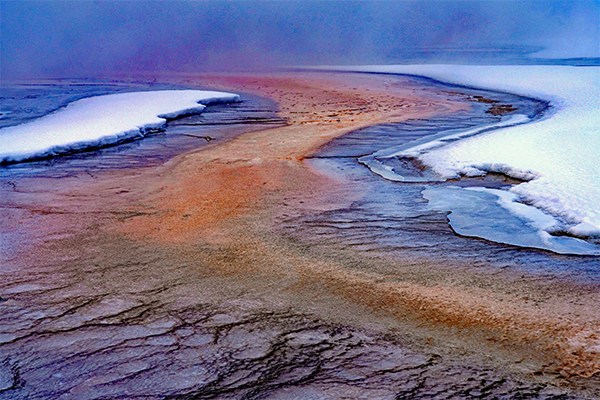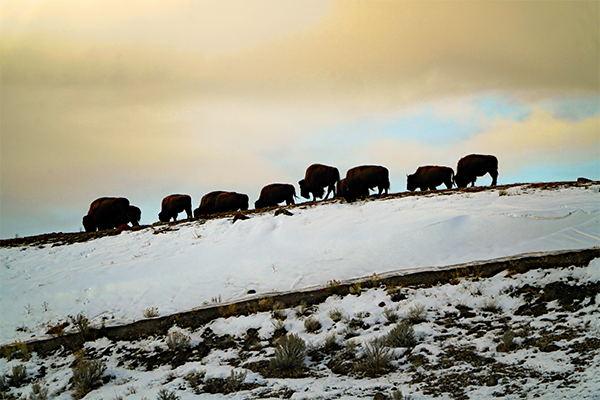A student perspective on a week’s journey through Yellowstone
The Sprinter van slows along the snow-covered road into Yellowstone National Park’s Lamar Valley. Our tour guide points out the window and a ripple of excitement passes through the group as we see three wolves pacing up a snowy hillside.
We rummage in our bags for binoculars and hang cameras around our necks. Our guide opens the doors, and we pile out into air that burns cold like peppermint. The snap of camera shutters fills the silence as we find and lose the wolves among the rocky outcroppings that dot the slope. After several minutes they settle down for a midmorning nap: noses tucked under tails, twitching ears silhouetted against snow and sky.
“I am going to go home and say we saw twenty-six wolves!” says Chris Johns, ’74, wildlife photographer, former editor-in-chief of National Geographic and leader of our trip. We all agree: seeing 26 wolves — even if 23 of them were black spots two miles away — is quite a tale.
I’m on the OSU Alumni Association’s weeklong Winter Photography trip to Yellowstone National Park with 11 alumni to photograph and learn about the Greater Yellowstone Ecosystem. As a natural resources student, I’m excited to experience the animals and landscapes that are so unique to the park, and as a writer, I’m excited to hear the stories tied to it. Perhaps it’s appropriate that on our first day in the park we are gifted with our own wolf story.

Wolves have a special history in Yellowstone National Park and the Greater Yellowstone Ecosystem, which has been chronicled, in part, by OSU’s own Professor Bill Ripple, Ph.D. ’84, and Professor Emeritus Robert Beschta. In the early 1900s, we learn, predators, including wolves, were culled to favor the herds of elk and other ungulates that drew visitors to the park. By the 1970s, wolves had exchanged their home in Yellowstone for one on the endangered species list.
Without them, the entire ecosystem deteriorated, sparking concern among ecologists and conservationists. Starting in 1995, biologists from the U.S. and Canada reintroduced wolves to the landscape in a politically controversial attempt to heal it.
Today’s park teems with wildlife. As we ride along, we call out different species to Sue Arndt, ’76, MHEC ’82, who keeps a running list in her notebook. Exiting the park into the town of Gardiner, Montana, I glance out the window onto a scene straight from the pages of a vintage visitor’s pamphlet. A herd of bison is grazing high on a snowy ridge, arranged so artistically that I mistake them for a sculpture. “Stop! Stop! Stop! Look! Bison 10 o’clock!” Shouts go up from the group, and our guide brings the van to a halt.
A windswept cumulous cloud rises behind the herd, silhouetting their broad backs. “It looks like a photo from the 1950s,” someone behind me comments.
“There’s your picture,” Johns says. “You’ve got the bison, and the ridge, the clouds and the sun. That’s sweet.” On cue, shutters start snapping.
Millions of bison once grazed the prairies of North America. However, to make way for westward expansion, the federal government encouraged their mass slaughter until only a handful remained. Reintroduction efforts have helped bison recover, a fact that is obvious to anyone who has been stuck in a traffic jam waiting for a herd to cross the road.
"A herd of bison is grazing high on a snowy ridge, arranged so artistically that I mistake them for a sculpture."

But what you see doesn’t tell the whole tale, explains David Quammen, a longtime Bozemanite, friend of Chris Johns, and writer of many highly acclaimed books including Yellowstone: A Journey Through America’s Wild Heart. Over dinner one evening, he talks to us about habitat fragmentation. Barriers, like highways or barbed wire fences, chop up the landscape, making it hard for the animals to access the resources they need.
As tourists, we could have ignored the conflicts surrounding the park and limited our perspectives to the perfectly framed photograph. Instead, we embraced them together: asking questions and listening to stories that challenged our pre-existing values and beliefs. This curiosity solidified our diverse group as Beavers (although dam-building beavers themselves pulled a no-show) and revealed the true nature of Oregon Staters as lifelong learners, adventurers, problem-solvers, scientists and storytellers.

